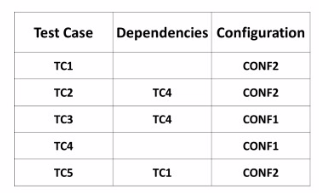Master BCS CTFL4 Exam with Reliable Practice Questions
For each test case to be executed, the following table specifies its dependencies and the required configuration of the test environment for running such test case:

Assume that C0NF1 is the initial configuration of the test environment Based on this assumption, which of the following is a test execution schedule that is compatible with the specified dependencies and allows minimising the number of switches between the different configurations of the test environment^
Correct : A
To determine the optimal test execution schedule that minimizes the number of configuration switches and respects the dependencies, we start with the initial configuration, CONF1.
TC4: It has no dependencies and runs on CONF1 (initial configuration).
TC3: Depends on TC4 and runs on CONF1. Since TC4 is already executed, we can proceed with TC3.
TC2: Depends on TC4 and runs on CONF2. We switch to CONF2 after TC3.
TC1: No dependencies and runs on CONF2. Since we are already in CONF2, we can execute TC1 next.
TC5: Depends on TC1 and runs on CONF2. Since TC1 is already executed, we can proceed with TC5 without additional configuration switches.
By following this sequence (TC4, TC3, TC2, TC1, TC5), we respect the dependencies and minimize the number of configuration switches
Start a Discussions
As a tester, as part of a V-model project, you are currently executing some tests aimed at verifying if a mobile app asks the user to grant the proper access permissions during the installation process and after the installation process. The requirements specification states that in both cases the app shall ask the user to grant access permissions only to the camera and photos stored on the device. However, you observe that the app also asks the user to grant access permission to all contacts on the device. Consider the following items:
[I]. Test environment
[ii]. Expected result
[iii]. Actual result.
[IV] Test level.
[V]. Root cause.
Based on only the given information, which of the items listed above, are you able to CORRECTLY specify in a defect report?
Correct : B
When writing a defect report, the tester can specify the expected result and the actual result based on the observation. The expected result is what the requirements specify, and the actual result is what was observed during testing. These elements are crucial for clearly communicating the nature of the defect to developers and other stakeholders. The other items such as test environment, test level, and root cause may not be clear or necessary at this stage of defect reporting.
Start a Discussions
Which of the following is a typical potential risk of using test automation tools?
Correct : D
One of the common risks associated with test automation tools is the underestimation of the effort required to maintain test scripts. Test scripts can become outdated or broken due to changes in the application, requiring significant effort to update and maintain them. This risk is highlighted in the ISTQB CTFL syllabus under the discussion of the benefits and risks of test automation.
Start a Discussions
Which of the following types of tools is BEST suited for determining source code compliance with the guidelines provided by a coding standard?
Correct : C
A static analysis tool is best suited for determining source code compliance with coding standards. These tools analyze the code without executing it and can check for adherence to coding standards, syntax errors, and other static properties of the code. The ISTQB CTFL syllabus emphasizes the role of static analysis tools in verifying that code meets predefined standards and guidelines.
Start a Discussions
Which of the following statements is NOT true about Configuration management and software testing?
Correct : D
While configuration management is crucial for maintaining consistent versions of software artifacts and supporting the build process, it does not directly increase the chances of finding defects in the software under test. Version-controlled test ware ensures that the correct versions of test cases and other test artifacts are used, but it is the quality and thoroughness of the tests that determine the effectiveness of defect detection. Reference: ISTQB CTFL Syllabus V4.0, Section 5.4
Start a Discussions